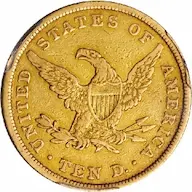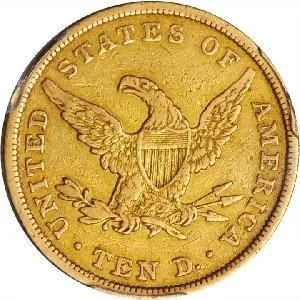1838 Coronet $10 Eagle
Events in Europe doomed early U.S. gold coinage. The French Revolution of the 1790’s, followed a few years later by Napoleon’s military exploits, drove the world price of gold higher. Unfriendly relations between the United States and Old World powers fueled gold’s rise also.(1)
In the U.S., the value of silver to gold was by law fixed at a ratio of 15:1. Elsewhere, the ratio fluctuated according to market conditions. By the early 19th century, an ounce of gold valued at 15 ounces of silver in America was worth about 16 ounces of silver in Paris and London. The precious metal content in U.S. gold coins made them worth more than their face value, if traded in Europe. Bullion profiteers seized upon this opportunity and shipped U.S. gold overseas for melting just as soon as it left the Philadelphia Mint.(2)
Profits were most easily realized for the largest U.S. gold coin at the time, the $10 gold eagle. The eagle was created by the Mint Act of 1792, and was deemed to be the flagship of American gold coinage.
Ultimately, nearly all eagles coined were lost to opportunists, and to halt this indignity, President Thomas Jefferson ordered production of the eagle (and silver dollar) halted in 1804.
By 1838, two laws had been enacted to encourage resumption of the $10 eagle. The first law, passed in 1834, reduced the weight and gold fineness of U.S. coins to deter gold speculators. This spurred much greater production and circulation of $2.50 quarter eagles and $5 half eagles. The 1837 law revamped the nation’s coinage operations and set the fineness of gold and silver at .900. After an absence of 34 years, the $10 eagle reappeared in 1838.(3)
Christian Gobrecht’s Coronet design depicted Miss Liberty looking left, wearing a small crown called a coronet, inscribed with the word LIBERTY. Her hair is tied in a bun with curls flowing down over the ear. The reverse features the eagle originally designed by Assistant Engraver John Reich in 1807. Many collectors refer to the $10 Coronet type as the Liberty Head eagle.
During 1839, Gobrecht retooled Liberty by removing some of the hair covering her ear and centering her over the date. Also, the lettering was reduced in size. In essence, these modifications constituted a two-year subtype of the Coronet $10 eagle.
As the first Coronet $10 eagle, and one of just two issues of the “Old Portrait” type, the 1838 is relentlessly pursued by experienced numismatists. The 1838 is much scarcer than the 1839 eagle of the same type. From the original mintage of 7,200 for the 1838, there are only about 85 survivors in all grades.(4)
| Estimated survivors in all grades: 85 ?
The survivor estimate from PCGS represents an average of one or more experts' opinions as to how many examples survive of a particular coin in all grades. Survival estimates include coins that are raw, certified by PCGS, and certified by other grading services. Learn more at PCGS. |
| PCGS Rarity Scale: 8.1 ?
The 'PCGS CoinFacts Rarity Scale' assesses the relative rarity of all U.S. coins, based on estimated surviving examples. The scale runs from 1.0 to 10.0. The higher the number, the rarer the coin.
Learn more at PCGS. |
| Search for the 1838 Coronet $10 Eagle on eBay** |
Preview of eBay selection (you may get more 1838 $10 results by clicking Search link above):
 |
 |
| Trendline Avg = 12.50 | CLASSIC RARITY |
 |
 |
| Trendline Avg = 12.50 | CLASSIC RARITY |
Historic Value Trend Charts:
| Last updated 9-06-25 | Return to Key Date Coin List | |
| Compare to Common Date Coin of Same Type | ||
|
|
||
| Download Charts to Your Computer | ||
Sources
1. Doty, Richard. America's Money, America's Story. Iola, WI: Krause Publications, 1998.
2. Taxay, Don. The U.S. Mint and Coinage. New York, NY: Sanford J. Durst Numismatic Publications, 1966.
3. Stack's Bowers Galleries. 1838 Liberty Head Eagle. Aug 2022 Auction.
4. PCGS. 1838 $10 (Regular Strike).
**Many very fine coin dealers sell on eBay. At any point in time, there may be over one million search results for United States coins. This includes quite a few of the recommendations on our Key Date Coin List.
If you’re thinking about purchasing a rare coin, eBay is certainly worth a look. For your convenience, the links from this site to eBay are coded to bring up only coins certified by PCGS and NGC.
As is always, always the case, never buy a valuable coin from a seller whose trustworthiness cannot be verified. Learn more about this at our chapter Best Places to Buy Coins, which also has a section on doing business on eBay.
In the interest of full disclosure, Rare Coins 101 receives a small commission anytime someone connects to eBay from this site and purchases something.
Coin images by Stack's Bowers Galleries.


